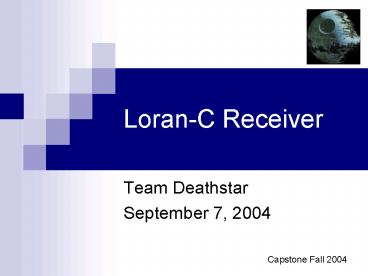LoranC Receiver - PowerPoint PPT Presentation
1 / 25
Title:
LoranC Receiver
Description:
Matt Anderson (ECE) Chris Birschbach (ECE) Christy Corner (EE) Matt Hayman (EE) Erin Mowbray (ECE) Background: What is Loran-C? ... – PowerPoint PPT presentation
Number of Views:113
Avg rating:3.0/5.0
Title: LoranC Receiver
1
Loran-C Receiver
- Team Deathstar
- September 7, 2004
Capstone Fall 2004
2
Group Members
- Matt Anderson (ECE)
- Chris Birschbach (ECE)
- Christy Corner (EE)
- Matt Hayman (EE)
- Erin Mowbray (ECE)
3
Background What is Loran-C?
- Loran-C is a navigation system that was developed
by the US Coast Guard. - The system is comprised of transmission stations
located around the world. - The Loran-C signal is transmitted from these
stations at specified intervals. - By measuring the time delay between transmissions
a user can determine their position relative to
the towers.
4
Loran-C Signal
5
Loran-C Signal continued
- The Loran-C signal is transmitted on a 100kHz
carrier.
6
Project Purpose
- Our group will design a receiver that will be
able to capture and decode the Loran-C signal
maintained by the United States Coast Guard. - Our system will consist of three main parts the
antenna/receiver, processing unit and personal
computer.
7
Project Funding
- Undergraduate Research Opportunities Program
(UROP) Grant. - Amount 1750
8
Tentative Budget
9
Project Objectives
- Capture a clean copy of the Loran-C signal
- Determine Time Delays
- Convert to a Latitudinal Longitudinal
coordinates.
10
Outline of Approach
- The system will consist of the following
subsystems - Antenna Receiver
- Analog-to-digital converter
- Motorola 68K processor
- Memory
- FPGA
- Serial Interface
- PC
- Power
11
Subsystems Diagram
Processing Unit
A/D Converter
Antenna/Receiver
FPGA
PC
Processor
RAM
12
Antenna Receiver Subsystem
- The antenna/receiver will consist of a loop
antenna with a active Butterworth filter to
capture and amplify the fundamental signal
received by the antenna. - This segment of the project serves the main
purpose of capturing the Loran-C signal with
minimal noise and preparing it for processing.
13
Analog-to-Digital Converter Subsystem
- The A/D converter will sample the analog signal.
- Sampling rate will be 1MHz.
- The digital data will be sent to the FPGA .
14
FPGA Subsystem
- The FPGA has a state machine for detecting the
third zero crossing of the Loran-C signal.
(Generates an interrupt) - It functions as a counter to measure the delay
between pulses. - It includes an interrupt controller for the
processor.
15
Processor Subsystem
- Upon generation of an interrupt, the processor
stores the counter data from the FPGA into RAM. - Performs operations on the counter data to
determine time delays and stores the delays in
RAM. - The microcontroller sends the time delay data to
the serial interface with the PC.
16
RAM Subsystem
- Holds the time delay and counter data for
processing and transmission.
17
Serial Interface Subsystem
- The communication interface between the PC and
the processor. - Consists of a serial shift register RS-232
logic level converter.
18
PC Subsystem
- Displays the time delays.
- Performs intensive conversion calculations to
convert data into Latitudinal and Longitudinal
coordinates. - Displays the Latitudinal and Longitudinal
coordinates.
19
Power
- Transform, rectify, and regulate voltage from
standard 120V/60Hz outlet to required DC
voltages. (Or purchase power supply) - Include portable power sources (battery or car
adapter) if time permits
20
Tasks
- Antenna Design
- Filtering
- PCB design
- Memory interface
- FPGA design
- PC programming
- PC interface
- A/D interface
- Processor programming
- Power
- Users Manual
21
Schedule
22
Division of Labor
- Matt A
- Power
- Memory interface
- Microprocessor Programming
- Chris B
- PC programming
- Microprocessor programming
- Users Manual
- Christy C
- Antenna/Filtering
- Verilog Design
- Users Manual
- Matt H
- Antenna/Filtering
- PCB
- Microprocessor Programming
- PC programming
- Erin M
- Verilog Design
23
Risks and Backup
- Receiving a clean copy of the signal
- (Can generate a fake signal)
- Baud rate generation for PC/processor
communication - Buffer overflow (Sample slower)
- Size and complexity of the state machine.
- (Can shift tasks from the FPGA to the processor
to compensate.) - RS-232 Communication on PC
- (Manually entering data into the conversion
program)
24
Above and Beyond
- If time permits we shall include a LCD display on
our receiver that displays the Loran-C time
delays. - Portable power sources.
- Cup Holders
25
Questions and Comments































